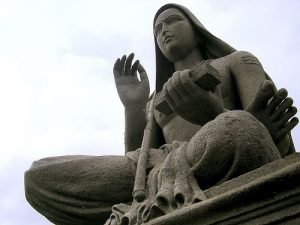Sunday, August 23, 2015
Adi Shankaracharya’s Jnana Yoga" – Br. Shankara”]
To move forward/backward through the talk, slide the gray bar that appears once audio is playing.
[/jbox]
August is a month for the study of Jnana Yoga, an approach to realization through analysis, discrimination, and reason. The goal is to regain your freedom from all limitation. Vedanta’s scriptures and teachers say that life’s misery — its pain, anxiety, and sense of imprisonment — is caused by seeing inaccurately, due to “maya.” As a jnana yogi, you may break through that framework of delusion and see only the Divine everywhere, in everything and everyone, including yourself.

Adi Shankaracharya (Shankara) was a great sage of 8th and 9th Century India (788-820 CE). Though only 32 at his death, he wrote highly revered interpretations of many traditional Hindu scriptures, including the Upanishads and Vedantic texts. Shankara’s books of instruction such as Vivekachudamani (Crest Jewel of Discrimination), and his renowned ability to defeat the leaders of other philosophical schools in debate, helped change the spiritual thought current of medieval India.
During the 9th Century, time-honored customs of Indian religious life had been fragmented or discarded. Materialism, mercenary priestcraft, superstition, and bigotry were prevalent. Shankara and his disciples helped restore the Vedic scriptures and non-dual (Advaita) Vedanta to their former prominence in Hinduism’s Perennial Philosophy (Sanatana Dharma). A social, cultural, and spiritual renaissance followed; its effects were felt in China, the Middle East, and in Greece and Rome.
In this talk, we define and discuss two practices that are central to Shankara’s teachings: viveka (discrimination between the unreal and the real), and vairagya (release of worldly desires and attachments).
Shankara says that — with active, sustained attention — discrimination and release will certainly lead an aspirant forward in spiritual life. And so, at last, to rebirth as a jivanmukta (one who is liberated while still embodied).